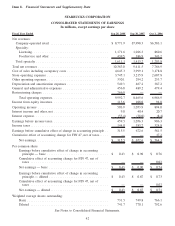Starbucks 2008 Annual Report Download - page 38
Download and view the complete annual report
Please find page 38 of the 2008 Starbucks annual report below. You can navigate through the pages in the report by either clicking on the pages listed below, or by using the keyword search tool below to find specific information within the annual report.
Operating Segments (in millions):
United States
Fiscal Year Ended
Sep 30,
2007
Oct 1,
2006
%
Change
Sep 30,
2007
Oct 1,
2006
As a % of US Total
Net Revenues
Net revenues:
Company-operated retail ........................ $6,560.9 $5,495.2 19.4% 89.3% 88.9%
Specialty:
Licensing ................................. 439.1 369.1 19.0 6.0 6.0
Foodservice and other ........................ 349.0 314.2 11.1 4.7 5.1
Total specialty ............................ 788.1 683.3 15.3 10.7 11.1
Total net revenues.............................. $7,349.0 $6,178.5 18.9% 100.0% 100.0%
Company-operated retail revenues increased primarily due to the opening of 1,065 new Company-operated retail
stores in the last 12 months and comparable store sales growth of 4% for fiscal 2007, nearly all resulting from an
increase in the average value per transaction. The US Company-operated retail business experienced deteriorating
trends in transactions late in the year, driven by, management believes, the US economic slowdown combined with
two price increases in US retail stores implemented in fiscal 2007.
Licensing revenues increased primarily due to higher product sales and royalty revenues as a result of opening 723
new licensed retail stores in the last 12 months. Foodservice and other revenues increased primarily due to growth in
new and existing foodservice accounts.
Fiscal Year Ended
Sep 30,
2007
Oct 1,
2006
%
Change
Sep 30,
2007
Oct 1,
2006
As a % of US
Total Net
Revenues
Cost of sales including occupancy costs ............... $2,956.2 $2,374.5 24.5% 40.2% 38.4%
Store operating expenses
(1)
........................ 2,684.2 2,280.0 17.7 36.5 36.9
Other operating expenses
(2)
........................ 204.8 190.6 7.4 2.8 3.1
Depreciation and amortization expenses ............... 348.2 284.6 22.3 4.7 4.6
General and administrative expenses ................. 85.9 93.8 (8.4) 1.2 1.5
Total operating expenses .................... 6,279.3 5,223.5 20.2 85.4 84.5
Income from equity investees ...................... 0.8 0.2 nm — —
Operating income ......................... $1,070.5 $ 955.2 12.1% 14.6% 15.5%
(1)
As a percentage of related Company-operated retail revenues, store operating expenses were 40.9% and 41.5%
for the fiscal years ended September 30, 2007 and October 1, 2006, respectively.
(2)
As a percentage of related total specialty revenues, other operating expenses were 26.0% and 27.9% for the
fiscal years ended September 30, 2007 and October 1, 2006, respectively.
Operating margin decreased due to higher cost of sales including occupancy costs, primarily due to a shift in sales
mix to higher cost products such as food and merchandise, higher distribution costs, higher rent expense and higher
dairy costs. Partially offsetting these were lower store operating expenses, lower general and administrative
expenses, and lower other operating expenses as a percentage of total net revenues. The decline in store operating
expenses as a percentage of total net revenues was primarily due to higher provisions for incentive compensation in
the prior year as well as leverage on regional overhead costs in fiscal 2007. General and administrative expenses
were lower primarily due to decreased salary and related benefits expense as well as lower professional fees. The
32
























